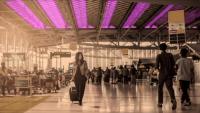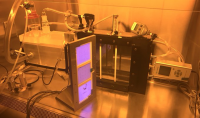Using the Power of Light: Preventing the Airborne Spread of Coronavirus and Influenza Virus

First International Congress on Far-UVC Science and Technology (ICFUST)
The Center for Radiological Research is hosting the First International Congress on Far-UVC Science and Technology (ICFUST) on June 14th-16th, 2023 at the Columbia University Irving Medical Center Vagelos Education Center.
This new conference series will bring together the Far-UVC community to discuss topics from basic laboratory science to regulatory standards and guidelines to applications in real world settings.
Over the past few years we've developed a promising technique to prevent the airborne transmission of viruses like influenza virus, which we would expect to be effective for coronavirus too. In short the idea is to use the power of light. Heres how it works:
- It's well known that conventional germicidal ultraviolet (UV) light reduces the person to person transmission of viruses through the air, by killing the viruses while they are in the air. Unfortunately conventional germicidal UV light is a safety hazard, as it causes skin cancer and and eye problems.
- What we have come up up with is a particular type of UV light ("far-UVC" light with a wavelength around 220 nm) which has only a very short range in biological material, so that it cannot penetrate the dead-cell layer at the surface of our skin, nor can it penetrate into our eyes. So it can't reach or damage any living cells in our body.
- But it can penetrate and kill viruses floating in the air, simply because viruses are incredibly small.
In short, exposure to far-UVC light is safe for people, but potentially lethal for viruses in the air.
We've worked a lot on both the safety aspects of far-UVC light as well as its efficacy at killing viruses, and it's looking very promising. A couple of companies have developed practical inexpensive far-UVC lamps and a US lighting fixture company is incorporating the far-UVC lamps into conventional light fittings.
The big picture idea is that these lamps could be incorporated into conventional light fittings so that they would be very easy to install in public spaces such as airports, trains stations, airplanes, etc. To us it looks like one of the very few approaches that has the potential to prevent the spread of coronavirus, as opposed to curing it.
You can learn more about our research on the use of far-UVC light to limit the spread of COVID-19 and how you can help here: https://crowdfund.columbia.edu/pages/cuimc-research
The video is an animated presentation of how the far-UVC works.
In the news:
Science Magazine: Could ultraviolet lamps slow the spread of flu?
Time: This UV Lamp Could Prevent the Flu Virus From Spreading in Public Places
Newsweek: UV Light May Help Fight the Flu Without Harming Humans
Yahoo News: This Special UV Light Could Zap Flu Germs from the Air
Wall Street Journal: New Ideas to Fight the Flu
CBS News: Fighting the flu with ultraviolet Light
Academic publication:
Scientific Reports: Far-UVC light (222 nm) efficiently and safely inactivates airborne human coronaviruses, June 2020
Scientific Reports: Far-UVC light: A new tool to control the spread of airborne-mediated microbial diseases, Feb. 2018
Radiation Research: Germicidal Efficacy and Mammalian Skin Safety of 222-nm UV Light, Apr. 2017
